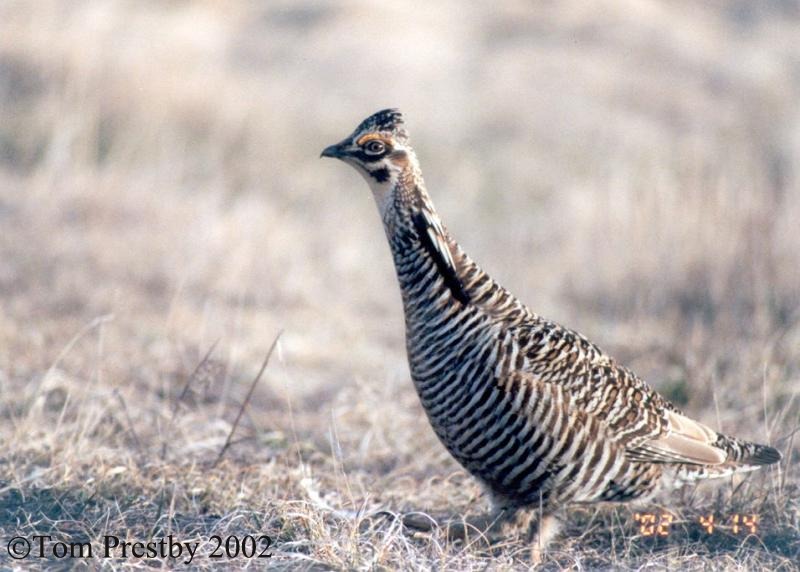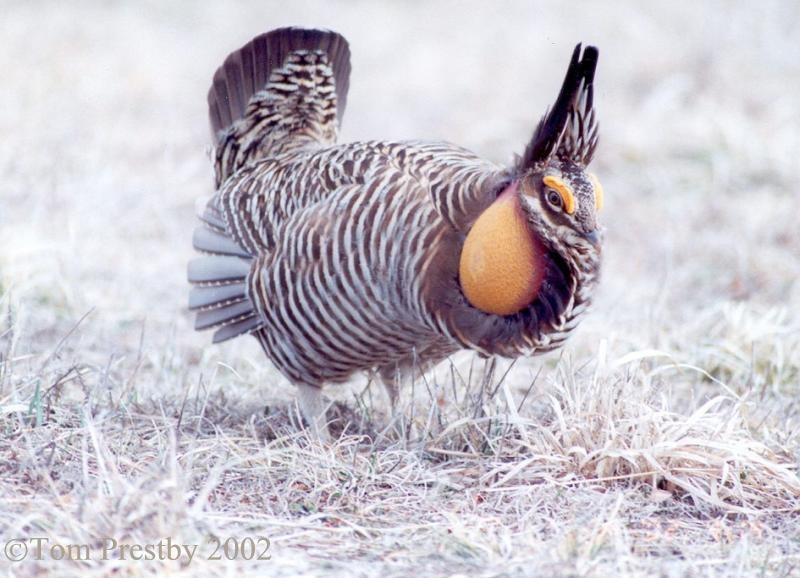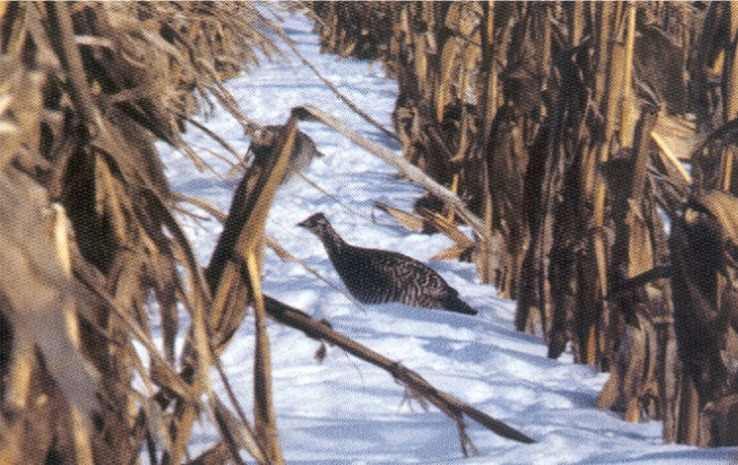Wisconsin's Prairie Chickens
Habitat
 T
The fate and future of the greater prairie chicken in
Wisconsin is tied to effective management of its habitat: securing the land they
need allows these birds to manage their own survival remarkably well.
The term "extirpation" often is used when discussing prairie chicken
survival. This means the bird is gone from a specific area, typically a state,
but is present elsewhere; it is uprooted but not extinct. Threatened
extirpation of these birds has had more to do with loss of dependable grassland
- be it oak barrens or prairie - than many lifetimes of hunting.
Original prairie chicken range consisted of the prairie/savanna area
of southern Wisconsin. Today the birds are found only in central Wisconsin on
the Buena Vista Grassland where careful management provides protected grassland
habitat.
Buena Vista Grassland
The area that today constitutes the premiere property in Wisconsin's
Prairie Chicken Management Program once was part of the "great marshes" of
central Wisconsin. In the early 1900s, draining and ditching transformed Buena
Vista Marsh into pasture, grass seed fields, and cropland. The WDNR-managed
portions, now called Buena Vista Grasslands and totaling more than 11,000 acres,
were acquired in a scatter pattern of ownership referred to as "ecological
patterning." Today, over 15,000 acres have been acquired for prairie chicken
management, thanks in large part to the people and

organizations who stepped in
to preserve the last fading voice of the prairie wilderness.
Re-creating this grassland before it was too
late became the goal of WDNR wildlife biologists. Today, Wisconsin's Prairie
Chicken Management program is recognized throughout the United States as a
successful model of habitat management. Many states to the east no longer have
prairie chickens. For Missouri, Minnesota and the few other states where prairie chickens still
exist in sizable numbers, Wisconsin is "holding the line" against the westward
march of extirpation.
More than three decades of habitat restoration and land-use research
at the Buena Vista Grassland have helped scientists and conservationists across
the country understand what it takes to protect this threatened species. For
the greater prairie chicken, this means constantly testing the mix and blend of
landscapes that make up the habitat - grasslands, cropland, pasture and woods -
where the bird must be able to survive.
 The greater prairie chicken relies on a
combination of open field and lowland cover. Mating rituals - that dawn
performance of booming males and interested females - require an unobstructed
view as male birds jockey for dominance and attention. After breeding, suitable grassland
with plenty of insects and a measure of security from predators is required for
nesting and raising young. Habitat management makes certain the prairie chicken
range can support these most basic needs.
The greater prairie chicken relies on a
combination of open field and lowland cover. Mating rituals - that dawn
performance of booming males and interested females - require an unobstructed
view as male birds jockey for dominance and attention. After breeding, suitable grassland
with plenty of insects and a measure of security from predators is required for
nesting and raising young. Habitat management makes certain the prairie chicken
range can support these most basic needs.
The change of seasons also plays a role in prairie chicken survival.
The greater prairie chicken in Wisconsin was once somewhat migratory, and a few
birds moved south into Illinois for the winter where conditions were milder.
Now, because of the isolation of the remaining grassland habitat, the birds stay
in central Wisconsin year-round.
 A
Adapting as well as they can to the rigors of snow and cold,
the flocks seek shelter in undisturbed grass and brush, feeding on natural weed
seeds and in crop fields, whether harvested or not. On occasion, during winter,
prairie chickens can be seen perched in aspen trees feeding on buds.
Holding the line in central Wisconsin
involves the use of several effective methods of land management to maintain
ideal grassland habitat for the prairie chickens and other wildlife. Management practices include fire, farming and
grazing. These methods, used on WDNR-managed lands within the prairie chicken
range, produce a variety of important vegetation responses to grassland
disturbance.

